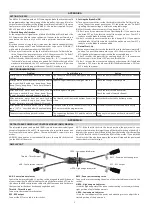
Aircraft Operating Instructions (AOI)
Type:
CT
Series:
CTLS
LSA
Page: 7-18
AU 010 11000
Revision No. 7
Date: 07 May 2009
wheel and engine / engine mount first. Deformation of the metal structure will absorb
much of the impact energy before the airframe itself is affected.
In non-deployed condition the belts are covered by the fuselage roof and stored
behind the main bulkhead. When deployed, typically the opening forces are strong
enough to pull these belts through the roof. In very rare cases (extreme low aircraft
weight and at stall speed) it might happen that the belts do not tear open the aircraft
roof. In this case the aircraft will come down with little more pitch down, and the rear
belt not tightened. Experience from a real CT ejection has shown this is a proper
descent position.
The following picture shows the installation of the two variants of recovery systems
used in the aircraft. The next illustration (not to scale!) shows the aircraft position
suspended under the parachute.
Installation of BRS rescue system (in container)
Installation of Junkers Magnum rescue system (Softpack)
















































